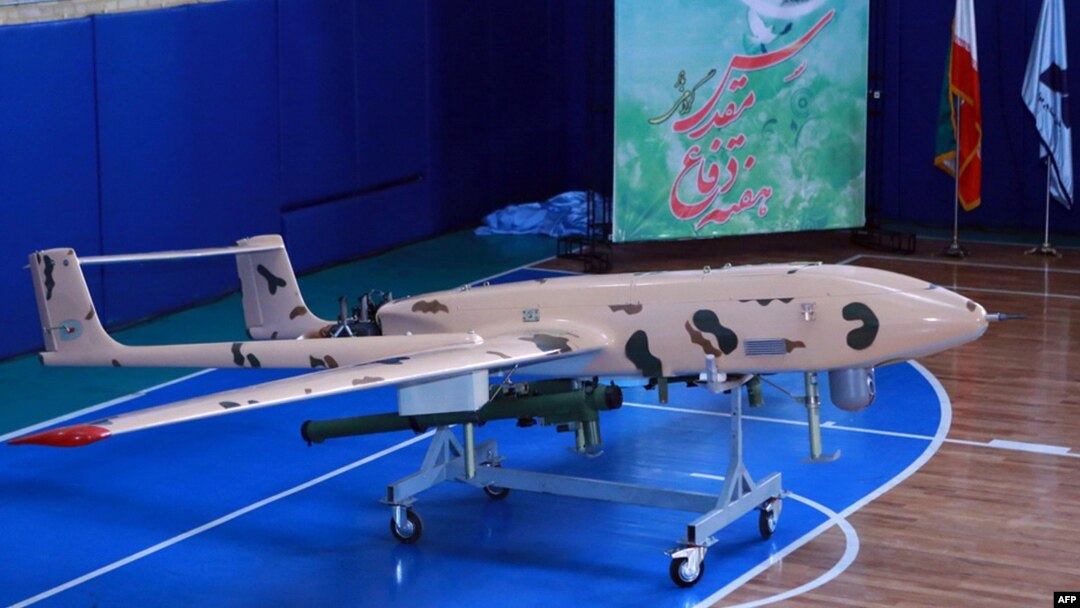Iran plans to take a defensive approach to stave off an enemy threat, deploying an army of combat robots, wheeled tanks, mother drones, and silent submarines.
Some key pieces of what President Hassan Rohani has described as Iran's "strategy of deterrence" were on parade during Iran's National Army Day festivities on April 18.
Tank On Wheels
Developers went off-track with the Aqareb wheeled tank, armed with a 90 mm main gun and a 12.7 mm machine gun. The odd-looking, eight-wheeled, tank reportedly holds a crew of four.
Combat Robot
The Nazir is a remote-controlled, four-wheel-drive robot. It can reportedly be programmed for reconnaissance and combat missions within an operational range of 2 kilometers.
Missile Defense
The Bavar-373 is an indigenous air- and missile-defense system designed with Russia's S-300 in mind. Development of the mobile, long-range, surface-to-air system was prompted by Moscow's ban on the delivery of the S-300 to Iran in 2010. That ban was lifted in April and Tehran has said it expects delivery by the end of the year.
Iran in 2014 announced that it had manufactured a Bavar-373, putting the program ahead of schedule, but the weapon remains untested. The S-300, which has been in production since the 1970s, could be a potential game-changer for Iran's air defenses, according to analysts.
Game Of Drones
In 2012, Iranian media reported that Tehran was developing a "mother drone" -- a pilotless aircraft capable of launching multiple microdrones. Designed by a student at Isfahan University, according to Iranian media, the as-yet-unseen craft is said to be capable of carrying five baby drones.
Iran is believed to have more than a dozen types of surveillance drones currently in existence, including the Fotros, which is Iran's largest unmanned aerial vehicle (UAV) and is said by Iranian officials to have a range of 2,000 kilometers.
According to a recent RAND report, Iran is still "unable to develop UAVs that can cruise high enough to avoid terrain yet low enough to avoid radar, especially against enemies on high alert, such as Israel or U.S. bases in the Middle East."
Iranian drones have been spotted in Syria and Iraq and have been shot down over Lebanon by the Israeli military.
Iran's surveillance drone program may have received a lift after the reported capture of an advanced U.S. drone in 2011.
Experts say that Iran has yet to develop weaponized drones, although Tehran has touted the potential use of large numbers of "suicide" drones to overwhelm and destroy enemy naval forces.
Underwater Threats
The Iranian Navy's submarine fleet is a point of pride. Iran has developed a broad range of diesel-electric submarines that could pose a threat to shipping, oil and gas wells, and foreign bases in the Persian Gulf.
"While diesel submarines have limited range, they are virtually undetectable unless they are moving," says Christopher Harmer of the Institute for the Study of War. "Diesel-electric submarines lying in wait to execute an ambush have a tactical advantage against the ships they target and ships that target them."
Tehran launched the 500-ton, 48-meter-long Fateh submarine, the largest it has ever built, in the Persian Gulf in 2013.
The country has also produced 19-meter Ghadir midget submarines and has been able to effectively redevelop its fleet of Soviet-era Kilo submarines.
For the future, Iran is reportedly developing unmanned, stealth, submarines to give it an edge in the Persian Gulf.
On the surface, Iran has launched a number of destroyers and has exhibited its navy's range with missions to the Mediterranean, the Red Sea, the Indian Ocean, and beyond to Southeast Asian countries. Most recently, Iranian warships were reportedly dispatched to the Gulf of Aden, which raised eyebrows amid the current conflict in Yemen and Iran's suspected support for rebel Huthi forces there.
Among its more quirky inventions, Tehran in 2010 unveiled a radar-evading flying boat named the Bavar 2.
Going Ballistic
Iran has a well-funded missile program and its arsenal is the largest and most diverse in the Middle East, according to experts.
The Islamic republic's arsenal includes several types of short-range and medium-range missiles. In 2013, it unveiled its self-produced Sejil and Ghadr missiles that have a range of up to 2,000 kilometers.
"They've put a lot of money in their ballistic-missile program," says Jeremy Binnie, an analyst with IHS Jane's. "They've extended the range of scud missiles so it can hit Israel and have also developed solar-fuelled missiles."
Iran is currently developing the Khalij Fars, an antiship ballistic missile.
Meanwhile, Iran's Simorgh space-launch vehicle has led to concerns that it could develop long-range intercontinental ballistic missiles that could reach Western Europe and the United States.
Unconventional, Yet Formidable
Western analysts describe some of the weapons Iran unveils each year as downright bizarre, militarily insignificant, and largely intended to serve as propaganda tools for domestic consumption. But some of Iran's weapons programs and military tactics could pose a threat to Western interests in the Persian Gulf and wider Middle East region.
"In a conventional sense, they're not strong at all in terms of ground forces, the air force, and navy, which are using predominately 1970s technology," Jane's Binnie says.
International sanctions and weapons embargos have prevented Tehran from acquiring Western weapons systems, prompting the domestic industry to skyrocket after the Islamic Revolution in 1979.
"What the Iranians have successfully done is use the technology they have at their disposal to pose a more unconventional, asymmetric threat to U.S.-allied forces in the Persian Gulf," Binnie says, adding that this has been reflected in some of the weapons systems and technologies that have been unveiled in the past.
U.S. defense assessments of Iran's military capabilities, while predominantly defensive, state that Tehran poses a growing threat.
The International Institute for Strategic Studies, a Britain-based think tank, says that while Iran's armed forces "suffer from a generally outdated arsenal, exacerbated by the imposition of a UN weapons embargo," their "innovative and cost-effective tactics and techniques mean that Iran is able to present a challenge to most potential adversaries."



